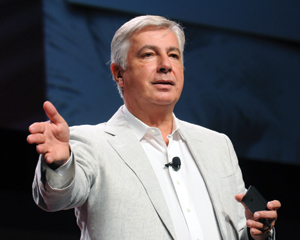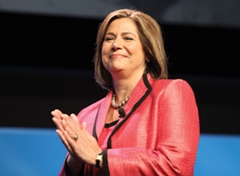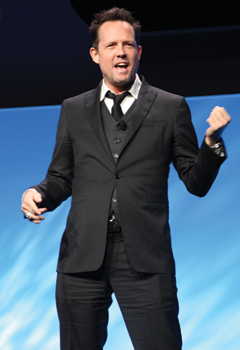The technology revolution is here to stay, and today’s top brand marketers are wrestling with how to keep up with it.
The rapid pace of change brought on by technology was the paramount issue discussed by senior executives gathered at the recent Association of National Advertisers annual conference in Orlando. Seeing a splintering of media further dividing audiences, and the rise of social and mobile platforms redefining the relationship between consumers and brands, marketers are slowly beginning to grow comfortable with the new reality of having less control of their brand messaging than ever.
“We’ve had to break the cycle of the one-way conversation,” said
Marc Pritchard,
Procter & Gamble global marketing and brand building officer. Pritchard offered a recent Febreze tweet “Don’t you wish you could throw your couch in a washing machine?” as a paradigm. “Marketing is now a democracy,” he said.
Marketers were warned to prepare for a future just ahead when technology will be so integral in their efforts that they will spend more in that area than even their CIOs or CTOs. And they were reminded that in today’s consumer market, competitive ads and price comparisons are as close to shoppers as their smartphones.
“The consumer has unprecedented control over the value chain now because of technology,” said Wal-Mart CMO Stephen Quinn, whose company recently began taking on online retailer Amazon with same-day delivery in some markets, while dropping sales of Amazon’s Kindle e-reader. “We’re focused on getting our marketing much closer to the moment and closer to the local market.”
Jim Farley, group vice president of global marketing, sales and service for Ford, told an audience of more than 2,000 attendees, “Mobile is the fastest growing technology that will affect us, and none of us have figured it out. … The key thing for us is location-based advertising. People who use mobile really use it for shopping.”
From the now-routine ads fashioned with user-generated content to the many varieties of social media, marketers were examining the ramifications of moving from a static delivery of messages to a more participatory experience.
“We are now responsible to be connecting with people in ways that are instructive and not disruptive,” said Kimberly Kadlec, worldwide vice president of Johnson & Johnson’s global marketing group. “We’ve been so used to the disruptive model, but now it is much more conversational. Disruption is over.”
A campaign for J&J’s Muppet Band-Aids — in which QR codes on the product launch animated, singing Muppets — served as a powerful example.
Citing something all city dwellers can relate to, Wal-Mart’s Quinn offered the umbrella vendors that appear instantly on city streets during rainstorms as the definitive example of merchandising. “We ought to be that nimble,” he said. However, with the changing media landscape comes changing responsibilities. “The [expanding] media piece is right in the center now for marketers,” Quinn said. “How are we going to do that [be nimble] and be responsible with budgets? It requires a different kind of thinking.”
It also was stressed that becoming content providers will require more money.
“You have to be in the content game,” said Subway CMO Tony Pace, citing his company’s direct-to-digital “4 to 9ers” sitcom, which “airs” on Hulu.com, as an example. “Consumers expect brands to have a good take on what they’re interested in. That’s the way you engage them.”
How much marketing has already been changed by technology? “Four or five years ago, 80 percent of what you did was planned and 20 percent was reaction,” Pace said. “Those numbers have flipped.”
 |
"The biggest issue is how a brand can center itself and not go astray simply because of all these new ideas and technologies."
Alfredo Gangotena
CMO, MasterCard
Photo by: CLARION PICTURES
|
Whereas marketers used to worry about speed-to-market for new products, speed and agility now are mandatory in the marketing department in order to stay in the expanding consumer conversation.
“Agility is now paramount,” said Lisa Donohue, CEO of media agency Starcom USA. “Technology is allowing us to build platforms in real time that can scrape the social media atmosphere, figure out what’s being said and build a platform to push that message back out.”
Added MillerCoors CMO Andy England, “Media is only going to get more complex, and those who can distill it best will be ahead.”
However, other big-brand stewards cautioned fellow marketers not to sacrifice brand equity for the sake of the latest marketing widget. “The biggest issue is how a brand can center itself and not go astray simply because of all these new ideas and technologies,” said MasterCard CMO Alfredo Gangotena.
Necessitated by the rising importance of social media, brand after brand showcased “purpose marketing” programs. Included was Coca-Cola’s increased sustainability efforts, J&J’s “Campaign for Nursing’s Future” and Uniliver’s efforts around providing clean drinking water to underdeveloped countries. Certainly, cause-related marketing is not new, but increasingly, large brands are pushing those efforts out front.
“There’s a change. Brands and companies are trying to show what they stand for,” said
Ed Erhardt, president of
ESPN global customer marketing and sales. “There are so many ways to interact with consumers, now the biggest thing for me is how focused every marketer was on navigating multiple touch points. The good news for us is that sports remain a gold standard in term of where marketers look for reach and engagement.”
With Allstate’s “Mayhem” a hit campaign, the company showed that popular TV ads can still captivate consumers and re-energize a tired brand. The presentation by Lisa Cochrane, Allstate senior vice president of marketing, included a live appearance by Dean Winters, who plays Allstate’s chilling “Mayhem” character. The campaign, which she revealed was not tested with consumers before its debut, has allowed Allstate to effectively restate its proposition as a
 |
Allstate’s Lisa Cochrane introduced some “Mayhem” into the 2012 ANA annual conference, bringing actor Dean Winters (above) from the brand’s popular spots.
Photo by: CLARION PICTURES (2)
|
full-service insurance provider compared with low-cost direct providers, such as Geico. “It causes some doubt and makes consumers wonder if they are really covered,” she said.
There may be nothing more daunting then selling the value of sponsorship in a room filled with the biggest advertising buyers in America, but P&G’s Pritchard did a credible job, offering a primer based on the success of his company’s TOP worldwide Olympic sponsorship, paired with the poignant “Thank You, Mom” campaign from Wieden & Kennedy. Pritchard said P&G is on track to realize $500 million in incremental sales from its Olympic marketing push.
“The key lesson for us in sponsorship is that you really need to find insights into why your brand should be part of any sponsorship equation,” Pritchard said. “Athletes are human: They wash their hair, they brush their teeth, they shave, they buy diapers. … We are in the business of helping moms. That’s why we sponsor the moms. We had to find that linkage. If you don’t find that linkage, it isn’t authentic.”
Terry Lefton can be reached at tlefton@sportsbusinessjournal.com.








